No.
As reported by Robin Miller of CBAR, a Debtor has burden of proving that Chapter 13 plan was proposed in good faith after issue is raised.
Once the issue of a Chapter 13 debtor’s good faith has been raised by the trustee, a party in interest or the court, the debtor has the burden of proof to establish his good faith. In re Caldwell, 895 F.2d 1123 (6th Cir. 1990).
In In re Larson-Asplund, 519 B.R. 682 (Bankr. E.D. Mich., Oct. 8, 2014), the court held that multiple non-exclusive factors must be considered in determining whether Chapter 13 plan was proposed in good faith.
To determine whether a Chapter 13 plan is proposed in good faith under Code § 1325(a)(3), courts have considered a non-exclusive list of factors, none of which are dispositive, described in In re Alt, 305 F.3d 413 (6th Cir. 2002).
The Chapter 13 debtor’s plan was not proposed in good faith under Code § 1325(a)(3) where the debtor was not eligible for a discharge, due to his prior Chapter 7 discharge; the plan proposed only minimal payments to unsecured creditors; and the purpose of the plan appeared to be to delay payment of a $30,000 judgment owed to the debtor’s former wife.
(case no. 2:14-bk-44240) (Chief Bankruptcy Judge Phillip J. Shefferly)
